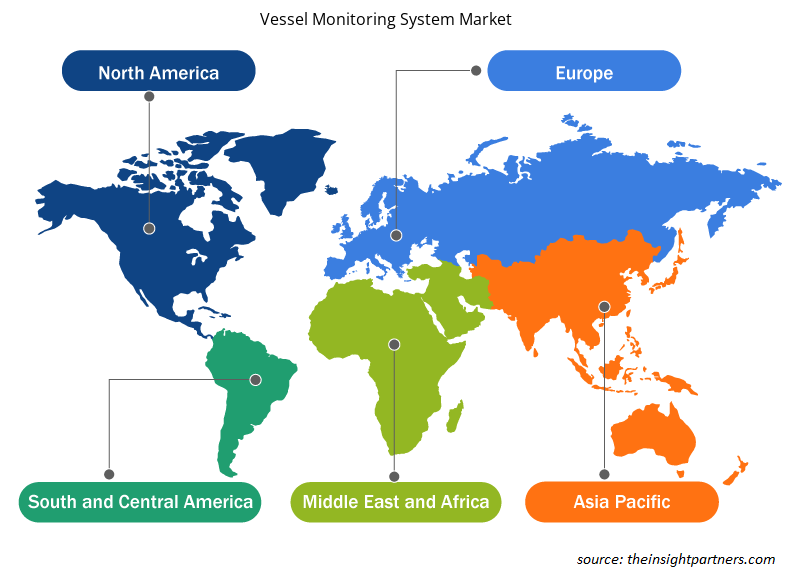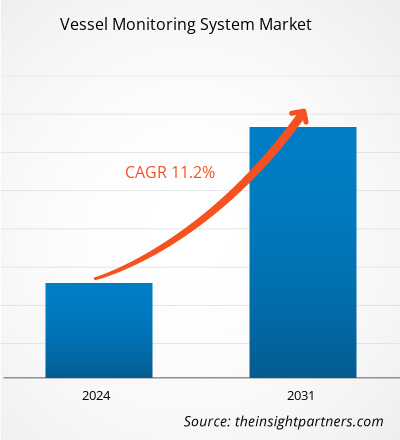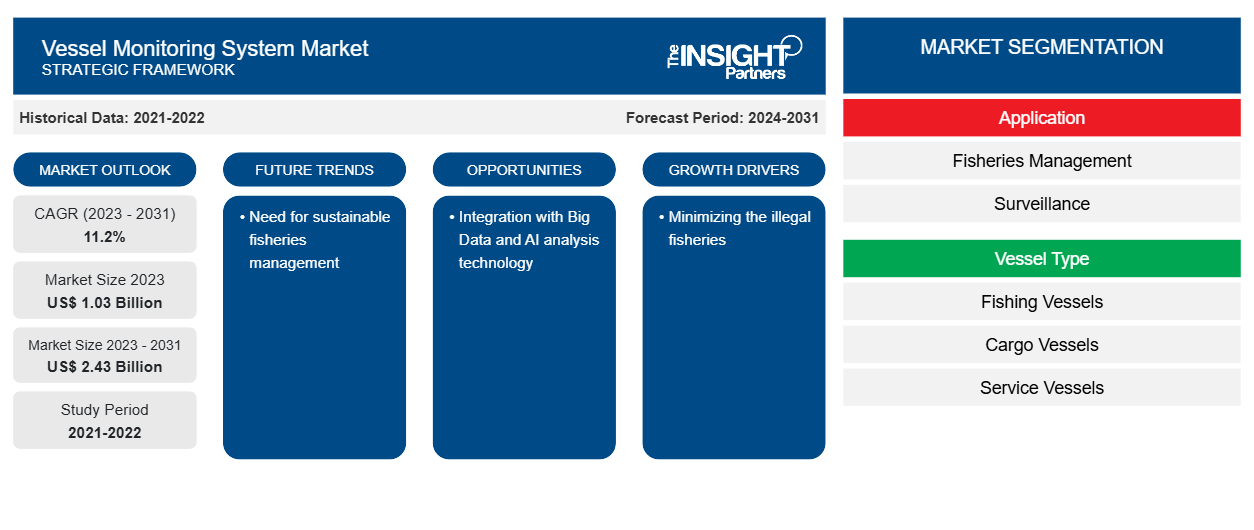船舶监控系统市场规模预计将从 2023 年的 10.3 亿美元增至 2031 年的 24.3 亿美元。预计 2023-2031 年市场复合年增长率将达到 11.2%。渔业应用的增长和防止未经授权交易的要求可能仍是船舶监控系统市场的主要趋势。
船舶监控系统市场分析
通过保证适当的捕鱼方法和防止非法捕鱼,船舶监测系统有助于改善海洋环境的管理和可持续性,从而保障和改善渔民的生计。船舶监测系统主要用于渔业管理。船舶监测系统的目的是监测配备 VMS 的船只在禁渔区内的移动情况。向可持续渔业管理的转变产生了对船舶监测系统的需求。
船舶监控系统市场概况
船舶监控系统 (VMS) 是一个常用术语,用于描述商业捕鱼中使用的系统,以便环境和渔业监管组织监控和跟踪渔船的活动。它们是国家和国际层面监控和监视 (MCS) 计划的重要组成部分。VMS 还用于监控和跟踪一个国家或一个国家下属区域领海内的船只。
定制此报告以满足您的需求
您可以免费定制任何报告,包括本报告的部分内容、国家级分析、Excel 数据包,以及为初创企业和大学提供优惠和折扣
-
获取此报告的关键市场趋势。这个免费样品将包括数据分析,从市场趋势到估计和预测。
船舶监控系统市场驱动因素和机遇
尽量减少市场参与者的非法捕捞行为,以利于市场
渔业是全世界人民食物、娱乐、就业、贸易和经济福祉的重要来源。随着人口增长和饥饿持续,鱼类已成为实现粮食安全的关键商品。然而,非法、未报告和无管制的捕捞活动严重危及国际社会确保渔业可持续性的努力。根据联合国粮食及农业组织 (FAO) 的数据,2023 年 6 月,非法、未报告和无管制的捕捞活动每年造成 1100 万至 2600 万吨鱼的损失,估计经济价值为 100 至 230 亿美元。因此,为了最大限度地减少非法渔业,对船舶监测系统的需求日益增加。它有助于有效、可靠地监测持牌渔船, 并 检测非法或未经授权的船只。
可持续渔业管理的需求——船舶监控系统市场的机会
全球超过 26% 的二氧化碳排放和超过 93% 的热量被海洋吸收。这影响了 5 亿人的健康、福祉和生计依赖于捕鱼,因为它改变了海洋生态系统,导致海平面上升,增加疾病爆发的频率,海水酸化,增加主要物种的死亡率和降低生产力,并改变了许多重要鱼类种群的地理分布。此外,不可持续的捕捞会导致渔船队排放污染物并破坏海洋生态系统,这两者都是导致气候变化的因素。因此,有必要实施可持续渔业管理,这就产生了对船舶监控系统的需求,因为它有助于为当局/组织提供强大的近乎实时的洞察,以可持续地管理和控制渔业活动。
船舶监控系统市场报告细分分析
有助于得出船舶监控系统市场分析的关键部分是应用和船舶类型。
- 根据应用,市场分为渔业管理、监视和其他。 2023 年,监视部分占据了更大的市场份额。
- 根据船舶类型,市场分为渔船、货船、服务船、客船和渡轮等。 2023 年,渔船部分占据了最大的市场份额。
船舶监控系统市场份额按地区分析
船舶监控系统市场报告的地理范围主要分为五个区域:北美、亚太、欧洲、中东和非洲、南美/南美和中美。
就收入而言,亚太地区在 2023 年占据了最大的船舶监控系统市场份额。日本、印度、中国、斯里兰卡等国家是亚太船舶监控系统市场的主要国家。该地区从事各种海事项目,需要船舶监控来确定船舶位置、其他交通和与天气有关的危险。它还负责监督港口或水道的综合交通管理。例如,2023 年 5 月,日本国家海洋研究所发布了一项新的船舶数据分析项目的结果,该项目将船舶数据中心 (ShipDC) 存储的船上监控数据与日本气象协会 (JWA) 提供的 POLARIS 海洋数据服务的信息相结合。
船舶监控系统市场区域洞察
Insight Partners 的分析师已详尽解释了预测期内影响船舶监控系统市场的区域趋势和因素。本节还讨论了北美、欧洲、亚太地区、中东和非洲以及南美和中美洲的船舶监控系统市场细分和地理位置。

- 获取船舶监控系统市场的区域特定数据
船舶监控系统市场报告范围
| 报告属性 | 细节 |
|---|---|
| 2023 年的市场规模 | 10.3亿美元 |
| 2031 年市场规模 | 24.3亿美元 |
| 全球复合年增长率(2023 - 2031) | 11.2% |
| 史料 | 2021-2022 |
| 预测期 | 2024-2031 |
| 涵盖的领域 |
按应用
|
| 覆盖地区和国家 |
北美
|
| 市场领导者和主要公司简介 |
|
船舶监控系统市场参与者密度:了解其对业务动态的影响
船舶监控系统市场正在快速增长,这得益于终端用户需求的不断增长,而这些需求又源于消费者偏好的不断变化、技术进步以及对产品优势的认识不断提高等因素。随着需求的增加,企业正在扩大其产品范围,进行创新以满足消费者的需求,并利用新兴趋势,从而进一步推动市场增长。
市场参与者密度是指在特定市场或行业内运营的企业或公司的分布情况。它表明在给定市场空间中,相对于其规模或总市场价值,有多少竞争对手(市场参与者)存在。
在船舶监控系统市场运营的主要公司有:
- 应用卫星技术有限公司
- 创值科技
- 北京海兰信数码科技有限公司
- 蓝讯科技
- 中立证券
- 轨道交通通讯
免责声明:上面列出的公司没有按照任何特定顺序排列。

- 了解船舶监控系统市场顶级关键参与者概况
船舶监控系统市场新闻和最新发展
船舶监控系统市场通过收集主要和次要研究后的定性和定量数据进行评估,其中包括重要的公司出版物、协会数据和数据库。以下是市场发展列表:
- 2021 年 3 月,莫迪总理启动了“2021 年印度海事峰会”,并推出了《2030 年海事愿景》电子书,旨在使该行业与全球顶级基准保持一致。印度推出了一个实时船舶跟踪系统,可以在需要时为海员和渔民提供帮助。除了在全球范围内跟踪印度船只外,它还可以跟踪印度海岸线 1,000 公里范围内的外国船只。(来源:新闻,新闻稿,2021 年)
- 2022 年 6 月,24-7 渔业监测中心 (FMC) 于 2022 年 6 月 21 日正式启用,这是国际移民组织 (IOM) 实施的斯里兰卡船舶监测系统 (VMS) 项目的一部分。根据斯里兰卡 VMS 项目,4200 艘多日渔船 (MFV) 配备了 VMS 转发器,这将使 DFAR 能够有效监测 MFV 的移动,确保遵守印度洋金枪鱼委员会 (IOTC) 关于非法、未报告、无管制 (IUU) 渔业的规定。(来源:IOM,新闻稿,2022 年)
船舶监控系统市场报告范围和交付成果
“船舶监控系统市场规模和预测(2021-2031 年)”报告对以下领域进行了详细的市场分析:
- 范围内所有主要细分市场的全球、区域和国家层面的市场规模和预测
- 市场动态,如驱动因素、限制因素和关键机遇
- 未来主要趋势
- 详细的 PEST/波特五力分析和 SWOT 分析
- 全球和区域市场分析涵盖关键市场趋势、主要参与者、法规和最新市场发展
- 行业格局和竞争分析,涵盖市场集中度、热点图分析、知名参与者和最新发展
- 详细的公司简介
- 历史分析(2 年)、基准年、预测(7 年)及复合年增长率
- PEST和SWOT分析
- 市场规模、价值/数量 - 全球、区域、国家
- 行业和竞争格局
- Excel 数据集
近期报告
客户评价
购买理由
- 明智的决策
- 了解市场动态
- 竞争分析
- 客户洞察
- 市场预测
- 风险规避
- 战略规划
- 投资论证
- 识别新兴市场
- 优化营销策略
- 提升运营效率
- 顺应监管趋势























 获取免费样品 - 船舶监控系统市场
获取免费样品 - 船舶监控系统市场